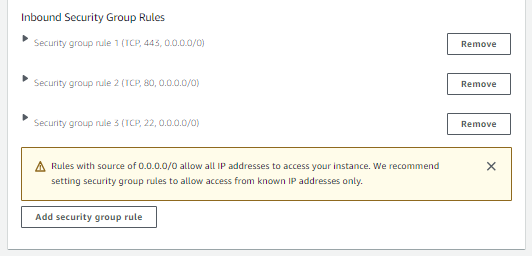Creating a Virtual Server
Signing in to AWS
- Sign in to your AWS account: https://console.aws.amazon.com
- After you have successfully logged in to the AWS portal, click Services > Compute > EC2.
Creating a Virtual Instance
- On the EC2 Dashboard, click the Launch Instance button.

- Enter the instance Name and add additional tags if necessary.
- Under Application and OS Images, click Browse more AMIs.
- Type "Haivision" in the search box and press Enter. If no results appear, click the AWS Marketplace AMIs tab.
- Find the Media Gateway/SRT Gateway image from the list. Click the Select button corresponding to the version of the Amazon Machine Image (AMI) you wish to use, PAYG or BYOL.

- Review the product and pricing details, and then click Subscribe Now.
Choose an Instance Type.
Note
- Only current generation instances, which are built on the Nitro system are supported and available for selection.
- For high bandwidth streams or critical viewing requirements, we recommend using Compute Optimized C5 Instances (e.g. c5.xlarge, c5.2xlarge, etc.) tiers, as they are optimized for compute-intensive workloads.
- See the following table for the correlation between the BYOL SKUs and the recommended AWS instance type.

HMG BYOL SKU HSG BYOL SKU AWS Instance vCPUs RAM Suggested # of Routes/Destinations — MI-SG10-AWS-BYOL c5.xlarge 4 8 GB - 10 Routes with 1 Destination each or
- 5 Routes with 2 Destinations each
MI-MG200-AWS-BYOL MI-SG20-AWS-BYOL c5.2xlarge 8 16 GB - 20 Routes with 1 Destination each,
- 10 Routes with 2 Destinations each, or
- 5 Routes with 4 Destinations each
MI-MG500-AWS-BYOL MI-SG50-AWS-BYOL c5.4xlarge 16 32 GB - 50 Routes with 1 Destination each,
- 25 Routes with 2 Destinations each, or
- 5 Routes with 10 Destinations each
— MI-SG-UL-AWS-BYOL c5.9xlarge 32 64 GB - 100 Routes with 3 Destinations each
Under Create key pair, select or create a public/private RSA key pair that is used to authenticate SSH sessions.
Note
SSH access to the Console UI is only allowed via SSH public key.
Under Network Settings, click Edit.
Tip
Choosing Enable under Auto-assign Public IP gives your server an IP address reachable from any location.

- Under Inbound Security Group Rules, make sure you have the following ports open:
- Port 80 and 443 for HTTP/HTTPS access to the web interface
- Port 22 for SSH access to the Console UI interface
Custom ports to allow incoming UDP traffic, such as SRT streams (use Custom UDP Rule). See SRT for more information.
Note
Only ports 80, 443, and 22 are open by default.

Under Configure Storage, set the amount of storage space you wish to make available to the server.
Tip
- The default storage is sufficient for most Media Gateway/SRT Gateway operations. However, if you intend to use Media Gateway/SRT Gateway in conjunction with a video server (such as using Media Gateway with Haivision Media Platform), having additional storage allows you to benefit from local caching on the virtual server.
- You may wish to choose Delete on Termination to have the storage space automatically removed if you cancel your subscription for the server instance. This option is disabled by default. Click the Advanced button to change this option on both volumes.
Under Advanced Details, ensure that Metadata version V1 and V2 (token optional) is selected.

Note
Support for IMDS v2 is expected in a future Gateway version.
- In Summary, leave the Number of Instances at 1.
- Review your settings, and make any necessary corrections or changes. When you are satisfied, click Launch Instance. A page appears, informing you that your instance is in the process of launching.

- After the instance successfully launches, click on the instance ID to view its properties:

- After the Instance State changes to "Running", reboot the virtual server by selecting it in the AWS View Instances page and clicking Instance State > Reboot.
- Confirm rebooting in the confirmation dialog box by clicking the Reboot button.

- Return to the AWS View Instances page. In the row corresponding to your server, take note of the Public IP address and Instance ID assigned by AWS to your instance. The Instance ID is the default password for signing into web interface.
At this point, your virtual server is up and running!
- If you have created a BYOL instance, before continuing you need to license your server. See Licensing Your Server.
- If you have created a PAYG instance, you are ready to sign in and begin using your server. See Signing in to Media Gateway.




